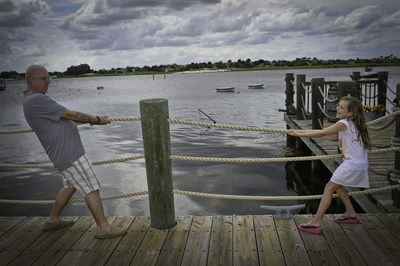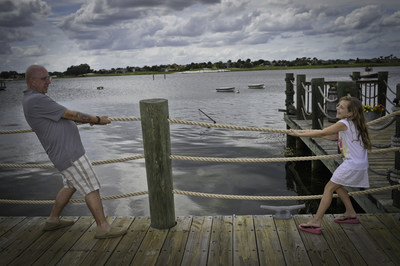Wounded Warrior Project Peer Mentor Guides Others Suffering in Silence
JACKSONVILLE, Fla., Sept. 9, 2016 /PRNewswire-USNewswire/ -- "Deep within the warrior is the spirit of a survivor," said Jim Mylott, a U.S. Army wounded warrior who now uses his struggle with depression and suicide as a platform to help others. "I survived."

In July 2003 at a checkpoint in Iraq, a large dump truck rigged with explosives came barreling through four Hesco military security barriers and headed straight toward Jim's convoy. "Back in the day, they didn't really use IEDs (improvised explosive devices); instead they packed their vehicles with explosives and came right at us."
Luckily, one of Jim's soldiers grabbed him and threw him inside the cab of a nearby Humvee. The selfless, quick thinking by his comrade saved Jim's life, but Jim fully absorbed the impact of the truck's collision, which crushed him helplessly inside the vehicle. The gunner of that vehicle was thrown from the turret of the vehicle, breaking his bones and ripping his face open up to his ear when his lip snagged an antenna.
The soldier who saved Jim's life was crushed between the vehicle and the dump truck. "He died, but not instantly, unfortunately. I listened to him dying and thought I was next."
Jim would later learn he was pulled from a 14-inch-wide pocket toward the front grille of the vehicle. The Hesco barrier's collapsible wire mesh now penetrated Jim's torso. He sustained many other severe physical injuries, but it was the invisible injuries that would haunt him.
"I woke up in the hospital with most of my memory gone, but I could not forget the face of one of my own dying. In my mind, his was the last face I saw before falling asleep and the first one I saw when waking up. It tormented me."
Jim spent the next two years in the hospital defying the doctor's diagnosis that he would never get out of his wheelchair. He not only did that, but he is also walking fully unsupported. Despite his physical therapy triumphs, Jim continued to lose the battle within.
"It's hard to admit you're having thoughts about suicide. I was dealing with severe survivor's guilt. It came to a night where I had my pistol in front of me and wasn't planning on seeing the next sunrise."
Sometimes, signs that inspire a big change can be small enough to miss—but not this one. At 2 o'clock in the morning something caught the corner of his eye.
"I saw a documentary – I stayed up all night and watched the whole thing," Jim said, adding that it was about Wounded Warrior Project® (WWP). "I saw the sunrise and made the first call into the WWP office that morning to get involved in their mental health programs."
To date, it is estimated that as many as 400,000 service members live with invisible wounds of war, including combat stress, depression, and finally – the signature wounds of Operation Enduring Freedom (OEF) and Operation Iraqi Freedom (OIF) – post-traumatic stress disorder (PTSD) and traumatic brain injury (TBI).
To address the growing mental health needs of injured warriors returning from battle, Wounded Warrior Project® (WWP) created its Combat Stress Recovery Program (CSRP). Through the generous support of donors, CSRP is able to offer veterans a number of specialized programs and services – each tailored to the veteran's specific needs – all free of charge. WWP and its supporters believe warriors already paid their dues on the battlefield, so warriors don't pay for any service they receive.
"No one talked about veteran suicide back in 2004. It took me a while to get in a good place. It was hard to tell people that I attempted suicide, but the programs at Wounded Warrior Project helped me break through the stigmas associated with mental health."
Beyond CSRP, Jim progressed his healing through the WWP Peer Support program. Peer support plays an important role in the recovery process as injured veterans rely upon each other's learned experiences when managing day-to-day challenges. All WWP programs and services have an aspect of this support structure, while the Peer Support program is solely dedicated to ensuring every injured veteran, family member, and caregiver encourage one another in recovery, thus embodying the WWP logo of one warrior carrying another off the battlefield.
Jim now helps other warriors suffering in silence. As a peer mentor, Jim recognizes that healing is a process and he knows the tools and skills necessary to continue progress. Warriors can become mentors when they demonstrate leadership strengths and the ability to help fellow wounded veterans who are in need.
"I always tell the guys I've been in their shoes," Jim said. "I've stood on that edge and dangled my toes off it. But if you look hard enough, you can always find something good with the bad. You have to find the positive because it's what gives you the hope to move forward. I don't consider the day of my injuries as the worst day of my life because if it never happened, I wouldn't have my wife who I met while I was in the hospital. I wouldn't have my daughter."
As Suicide Prevention Week draws to a close, it becomes imperative to keep veteran suicide and other mental health issues at the forefront of meaningful national dialogue. Jim represents many injured warriors who continue to struggle daily with the aftermath of sacrifices made on the battlefield.
The strength of survival comes from the depths of the soul.
"Deep down inside – even if it's so deep you haven't seen it in years – everyone has that ember," Jim said. "It's survival. It's the instinct to exist. I am a testament to it. I am living proof."
About Wounded Warrior Project
The mission of Wounded Warrior Project® (WWP) is to honor and empower Wounded Warriors. The WWP purpose is to raise awareness and to enlist the public's aid for the needs of injured service members, to help injured servicemen and women aid and assist each other, and to provide unique, direct programs and services to meet their needs. WWP is a national, nonpartisan organization headquartered in Jacksonville, Florida. To get involved and learn more, visit woundedwarriorproject.org.
Photo - http://photos.prnewswire.com/prnh/20160909/406088
SOURCE Wounded Warrior Project
